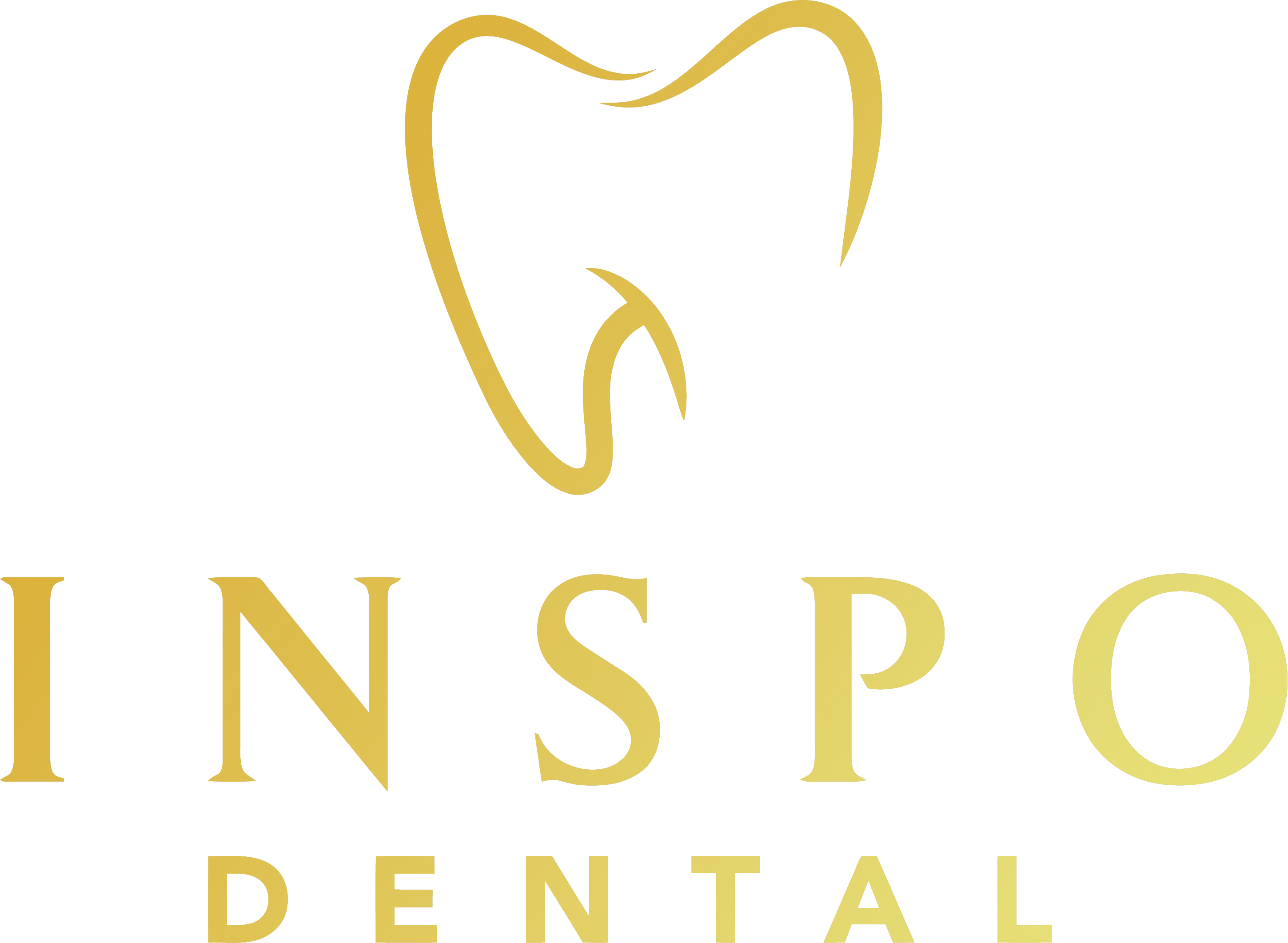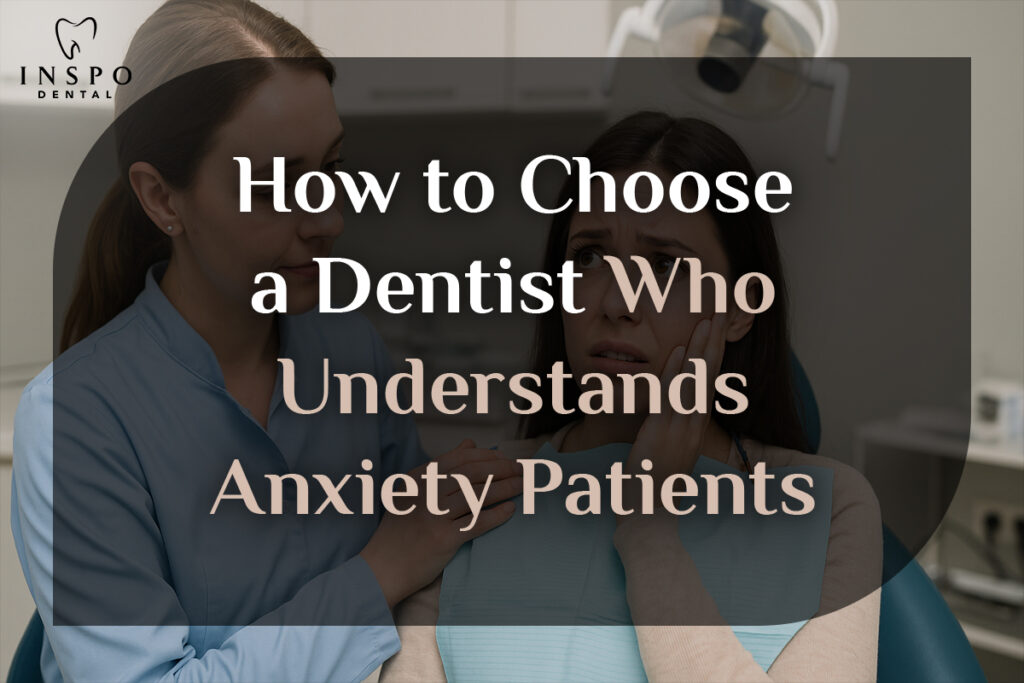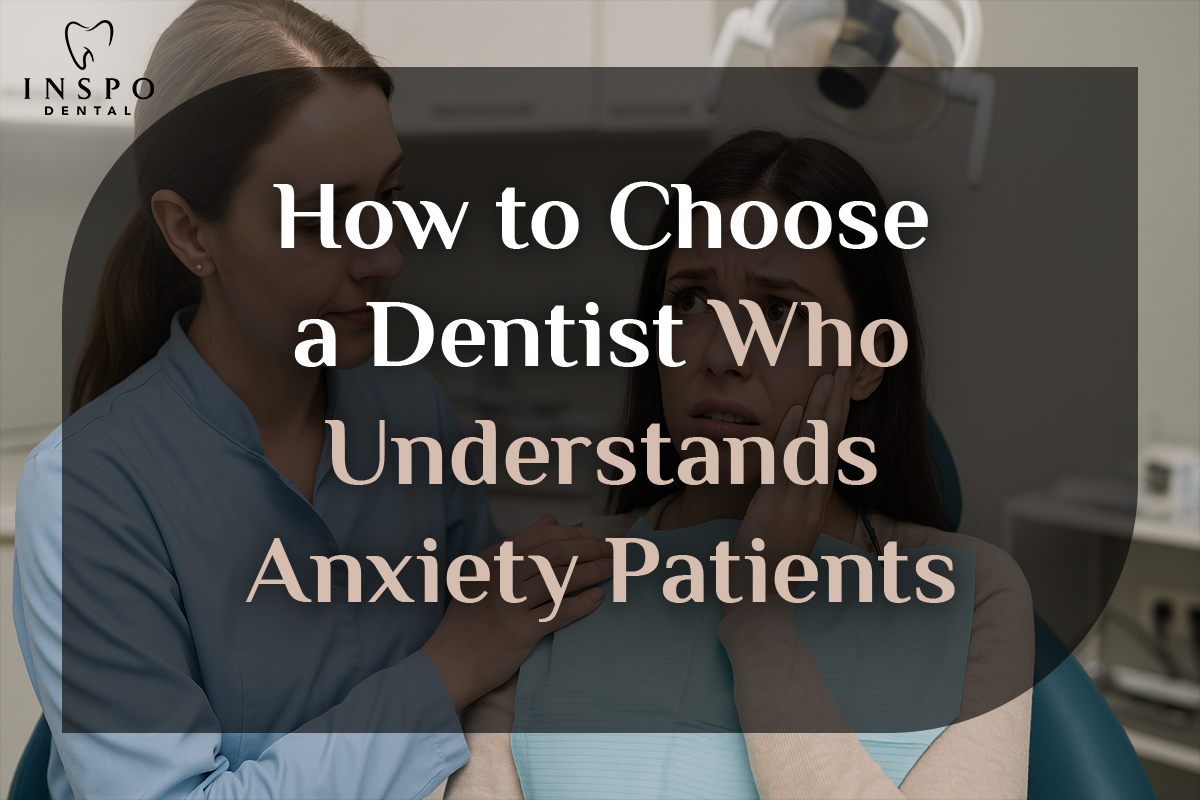The Overlooked Barrier to Dental Health
Dental anxiety is not a minor inconvenience—it’s a deeply personal fear that can prevent individuals from seeking essential oral care. Whether it’s the sound of the drill, fear of pain, or a past traumatic experience, millions of patients delay or avoid dental appointments altogether.
But here’s the good news: you don’t have to suffer in silence. With the right approach, you can find a dentist who not only understands anxiety but also creates a stress-free, judgment-free experience.
This comprehensive guide will show you how to choose a dentist who understands anxiety patients, what questions to ask, red flags to avoid, and the anxiety-reducing strategies modern dental practices now offer.
🔍 Understanding Dental Anxiety: What It Really Means
Dental anxiety can range from mild nervousness to full-blown phobia. Understanding the symptoms helps both patients and dentists provide better care.
✅ Common signs of dental anxiety:
- Sweating, racing heart, or difficulty sleeping before appointments
- Panic attacks in the waiting room or treatment chair
- Avoidance of dental care, even during emergencies
- Nausea, dizziness, or trouble breathing at the dentist’s office
Dental phobia is recognized as a legitimate condition—and dentists who are trauma-informed and anxiety-aware treat it with compassion, not judgment.
🏥 What Makes an Anxiety-Friendly Dentist Different?
Not all dentists are equipped to handle anxiety patients. The difference lies not just in technical skill but also in emotional intelligence and environmental design.
✅ Key traits of an anxiety-friendly dentist:
- Excellent communication and listening skills
- Patient, non-judgmental attitude
- Experience with sedation techniques and gentle procedures
- Staff trained in managing anxious patients
- A calming and supportive office environment
An anxiety-aware dentist doesn’t rush you—they build trust before touching a single tool.
📍 Step 1: Start With Research—But Focus on the Right Signals
Google and online directories are a good starting point, but the key lies in what you’re looking for.
✅ Look for signs that a dentist understands anxiety:
- Website mentions “anxiety,” “phobia,” or “nervous patients welcome”
- Availability of sedation options (oral sedation, laughing gas, IV)
- Patient testimonials that highlight comfort and care
- Mentions of spa-like amenities or comfort-focused services
Avoid practices that market themselves only around speed, efficiency, or pricing, without attention to the patient experience. Your comfort deserves more.
☎️ Step 2: Make the Call—And Judge the First Contact
When you call to schedule a consultation or ask questions, the tone and response of the front desk staff is your first indicator.
✅ Ask these questions:
- “Do you have experience with patients who have dental anxiety?”
- “What comfort options or sedation do you offer?”
- “Do you allow patients to visit the clinic before the first treatment?”
- “Can I meet the dentist first without undergoing a procedure?”
The staff should respond warmly and never make you feel rushed, judged, or silly for asking. If they sound annoyed or dismissive—move on.
💬 Step 3: Ask the Dentist These 7 Crucial Questions
Meeting your potential dentist is your chance to ensure they’re the right fit.
✅ During your first visit or consult, ask:
- “How do you handle patients with severe dental anxiety?”
- “What can I expect during a first appointment—no procedures?”
- “Are you open to using safe words or taking breaks during treatment?”
- “Do you offer sedation, and is it safe for anxious patients?”
- “Have you worked with patients who have had trauma or panic attacks?”
- “How do you help me stay in control throughout the appointment?”
- “Can I bring a friend or family member with me?”
The right dentist will answer these with confidence and kindness—not defensiveness.
🛋️ Step 4: Evaluate the Office Atmosphere
Environment plays a significant role in calming anxious patients. When you visit, pay close attention to your surroundings.
✅ Look for anxiety-friendly office design elements:
- Soft lighting and relaxing music
- Warm, friendly staff who explain every step
- Private or quieter waiting areas
- Aromatherapy or visual distractions like TV screens
- Clean, clutter-free space that doesn’t feel clinical
Bonus points for practices offering weighted blankets, headphones, or guided breathing apps—many modern clinics now include these.
🧪 Step 5: Understand Sedation & Comfort Options
A dentist who truly understands anxiety will offer flexible options—not a one-size-fits-all approach.
✅ Common comfort and sedation techniques include:
- Nitrous oxide (laughing gas): Helps calm mild to moderate anxiety.
- Oral sedation: A pill taken before the visit to promote relaxation.
- IV sedation: Used in more severe cases or lengthy procedures.
- Local anesthesia with enhanced pain management: For fear of pain.
- Distraction techniques: Music, movies, or guided imagery.
Discuss which is right for you, and don’t hesitate to ask about risks, benefits, and alternatives.
🧘 Step 6: Ask About Behavioral and Psychological Support
Some dental practices go a step further by integrating psychological techniques into their care. These dentists may be trained in:
✅ Emotional-support techniques:
- Cognitive Behavioral Therapy (CBT) for dental fear
- Systematic desensitization techniques
- Use of grounding and mindfulness during treatment
- Trauma-informed care language and behavior
- Pre-treatment coaching or counseling referrals
If you’re struggling with panic, trauma, or PTSD from past dental experiences, this extra layer of psychological sensitivity can be life-changing.
🧑⚕️ Step 7: Look for Red Flags (and Trust Your Gut)
Sometimes, what’s not said is just as important as what is. Be alert to signs that a dentist may not be equipped to handle your anxiety.
❌ Red flags to watch out for:
- “Just relax, it’s not a big deal.”
- Dismissive of your questions or tries to “tough love” you
- Uses fear-based language like “you’ll lose your teeth if you don’t…”
- Rushed appointments or lack of eye contact
- No clear consent process or safe-word policy
If the experience feels dismissive or disrespectful, trust your instincts and look elsewhere.
💡 Step 8: Consider Specialized Clinics for Dental Anxiety
In some regions, specialized dental practices cater exclusively to anxious or phobic patients. These practices often feature:
✅ Unique advantages of anxiety-specialist clinics:
- Staff trained specifically in anxiety and trauma care
- On-site sedation experts or anesthesiologists
- Treatment plans that prioritize emotional safety
- Longer appointments with no-pressure environments
- Optional therapy or coaching built into the treatment plan
Even if travel is required, this extra investment may result in long-term relief and confidence in receiving dental care.
📱 Step 9: Use Tech to Stay Informed & Empowered
Many anxiety-friendly dental practices now offer digital tools that enhance comfort and communication.
✅ Tech tools to look for:
- Mobile apps for appointment reminders & educational materials
- Virtual consults before in-person visits
- Online forms to avoid reception desk anxiety
- Explainer videos showing procedures beforehand
- Post-visit follow-up via email or text
Technology can help reduce surprises and empower you to feel more in control of your care journey.
📱 Step 10: Embrace a Slow, Customized Treatment Plan
One of the most impactful ways anxiety-aware dentists stand out is by offering personalized, phased care plans tailored specifically for anxious patients.
Unlike traditional dental practices that dive straight into procedures, anxiety-friendly dentists understand the importance of earning your trust over time.
✅ Here’s how a slow-paced treatment plan might look:
- Step 1: Meet & Greet Visit – No tools, just a friendly chat to get to know each other.
- Step 2: Guided Office Tour – Familiarize yourself with the surroundings before sitting in a dental chair.
- Step 3: Non-Invasive Exam – Optional gentle check-up with no pressure to proceed.
- Step 4: Collaborative Treatment Planning – You and your dentist decide the pace and priority.
- Step 5: Gradual Treatment – Begin with the least invasive procedures first.
- Step 6: Regular Feedback – Post-visit calls or surveys to adjust future appointments based on your comfort.
This approach makes dental care feel like a partnership—not a process being done to you.
🔁 Step 11: Consistency Builds Confidence Over Time
For patients with dental anxiety, continuity is everything. Switching dentists often resets your progress and revives old fears. That’s why building a long-term relationship with a single practice is so crucial.
✅ Look for practices that prioritize:
- Long-term patient-dentist matching
- Keeping the same hygienist and support staff
- Detailed records of your preferences and comfort needs
- Annual reassessments of your anxiety and treatment plan
- Celebrating progress (e.g., completing your first cleaning without sedation)
Over time, these consistent positive experiences retrain your brain to view the dentist as a safe space.
💬 Step 12: Community Support Can Make a Huge Difference
Believe it or not, you’re part of a much larger group than you think. Dental anxiety affects more than 36% of the population at some level. You’re not alone—and that’s powerful.
Many patients find healing by:
✅ Joining online support groups for dental phobia
✅ Reading success stories of others who overcame their fear
✅ Sharing your own journey with close friends or family
✅ Asking your dentist if other patients have walked a similar path
When you realize others have been through the same experience and come out smiling, it can give you the courage to take the next step.
🔄 Step 13: Reframe the Narrative Around Dental Visits
Fear often comes from how we think about the experience. An anxiety-friendly dentist may even help you reframe the way you approach appointments.
✅ Helpful mindset shifts:
- “I’m not weak—I’m brave for facing this.”
- “I’m not going to the dentist to be judged—I’m going to be helped.”
- “Even if I panic, they’ll support me through it.”
- “Every appointment is progress, no matter how small.”
This mindset shift is easier when your dentist validates your fear without amplifying it.
📋 Step 14: Request a Dental Anxiety Comfort Plan (DAC Plan)
Forward-thinking clinics now offer what’s known as a Dental Anxiety Comfort Plan (DAC Plan)—a personalized document outlining how you wish to be treated.
✅ A DAC Plan might include:
- Your preferred communication style (direct, gentle, detailed)
- What triggers your anxiety (needles, sounds, smells, authority tone)
- Sedation preferences and safe words
- Post-visit instructions to avoid feeling overwhelmed
- Emergency protocols if you have a panic attack during treatment
This plan gives you control, empowers your care team, and makes every appointment more predictable and manageable.
🛡️ Step 15: Insurance and Anxiety Support—Know Your Options
Some patients avoid care due to cost—but many insurance plans now offer coverage for sedation and comfort options, especially when diagnosed with dental phobia.
✅ Tips to navigate insurance for anxiety-friendly care:
- Ask if your plan covers oral or IV sedation.
- Request documentation from your primary care doctor or psychologist stating dental anxiety.
- Check for coverage under behavioral health or special needs dentistry.
- Look into CareCredit or dental savings programs tailored for comfort care.
Don’t assume anxiety care is a luxury—it’s part of your overall health, and many providers understand that now.
🌟 Step 16: Celebrate Milestones—No Matter How Small
Healing isn’t a straight line. Some appointments will feel better than others, and every small win is a step toward confidence.
✅ Milestones worth celebrating:
- Booking the appointment, even if you don’t go
- Walking into the clinic without turning back
- Sitting in the chair without sedation
- Completing your first cleaning or procedure
- Advocating for yourself with the dentist
Your dentist may even celebrate these with you—many anxiety-friendly practices give “comfort badges” or notes of encouragement after big wins.
🧩 Step 17: When to Consider Professional Therapy Alongside Dental Visits
Sometimes, the fear is too deep to overcome with dental support alone—and that’s okay.
Dental anxiety is often linked to:
- Past medical trauma
- Generalized anxiety disorder
- Sensory processing issues
- PTSD or childhood neglect
✅ In these cases, consider partnering with:
- A trauma-informed therapist
- A cognitive-behavioral specialist (CBT)
- A psychologist experienced in medical phobias
- A dental coach or anxiety mentor
Combining therapy with dentist visits can dramatically accelerate healing and restore your sense of autonomy.
🧠 Step 18: Educate Yourself to Reduce the Unknown
Fear often grows in the dark, when you don’t know what’s going to happen. That’s why one of the best ways to combat dental anxiety is to educate yourself in advance.
The more you know, the less power fear holds.
✅ Ask your dentist for:
- Simple walkthroughs of each procedure
- Diagrams or animations explaining tools and techniques
- Printed handouts or videos that prepare you for each visit
- Access to online resources with anxiety-friendly explanations
Many modern dentists are happy to explain everything step by step. Some even offer pre-visit orientation sessions for new anxious patients.
When you understand what’s happening and why, your brain begins to replace fear with familiarity.
🧪 Step 19: Don’t Be Afraid to Switch Dentists If You’re Not Heard
This is your health. Your body. Your comfort.
If your current dentist seems rushed, dismissive, or doesn’t take your anxiety seriously—even after you’ve expressed your concerns—it may be time to move on.
✅ Signs it’s time to find a new provider:
- You feel talked over, rushed, or minimized
- They use phrases like “it’s just in your head” or “toughen up.”
- Procedures begin before you feel ready or consent fully
- Your comfort requests are ignored or dismissed
- You leave appointments feeling worse than when you arrived
Finding the right fit is not just allowed—it’s essential. You are never “difficult” for wanting to feel safe.
🔄 Step 20: Recognize That Healing Is Not Linear
Anxiety recovery isn’t a straight climb. You might feel confident during one visit and nervous again the next—and that’s normal.
Dentists who specialize in anxious patients know this. They won’t expect perfection or pressure you to “perform bravery.”
✅ Tips for staying grounded:
- Celebrate progress, not perfection
- Keep a journal to track what helped (or didn’t) after each visit
- Tell your dentist honestly how you’re feeling, even if it’s “worse than last time.”
- Remember: each time you show up, you’re practicing resilience
True healing is building trust with yourself as much as with your dentist.
📣 Step 21: Advocate for Anxiety-Inclusive Dentistry in Your Community
If you’ve found a great anxiety-aware dental provider, don’t keep it a secret. Your story might help someone else take their first step, too.
✅ How you can help others:
- Leave an honest review describing how the dentist helped your anxiety
- Recommend them in local groups or on social media
- Suggest to your employer that they include anxiety-friendly dentists in insurance plans
- Encourage your dentist to host awareness sessions or create anxiety-specific web content
Dental phobia is widespread, but the movement toward compassionate, inclusive care is growing. Be part of it.
🧬 Step 22: When Kids Inherit Dental Anxiety—Break the Cycle Early
If you’re a parent who fears the dentist, your child may unconsciously absorb that fear as well.
But you have the opportunity to change that narrative—for them and you.
✅ Ways to reduce dental fear in children:
- Choose a pediatric dentist who welcomes nervous parents, too
- Never use the dentist as a punishment or threat (“If you don’t brush, you’ll have to get a shot!”)
- Let your child see you attend a checkup calmly, even if it’s hard
- Talk about dental visits like a normal health routine—not something scary or shameful
- Reward bravery, no matter how small
When kids experience early dental care as gentle, positive, and respectful, they’re less likely to grow up with the same fears.
🧭 Final Thoughts: Your Comfort Is Not a Luxury—It’s a Right
If dental fear has kept you from seeking the care you deserve, please know this: You are not weak, broken, or alone.
Modern dentistry has evolved. Compassionate, well-trained dentists now understand that emotional comfort is just as important as clinical care.
By following this guide, you’re taking a courageous step toward healing your relationship with dental care—on your terms, in your time.
✅ Summary Checklist: What to Look for in an Anxiety-Aware Dentist
Here’s a recap you can save or print when vetting dentists:
✅ Welcomes anxious patients on the website
✅ Offers sedation options & behavioral support
✅ Patient-first communication and safe-word policies
✅ Calm, non-clinical environment
✅ Flexible consultation process (no-pressure visit)
✅ Kind, experienced support staff
✅ Good online reviews from anxious patients
✅ Respects your boundaries & listens without judgment
📞 Your Smile Deserves Peace
Don’t let fear rob you of your health, confidence, or smile.
Start by booking a consultation—not a procedure—with a dentist who understands anxiety. Let them earn your trust, and take it one step at a time. You deserve care that feels safe.






